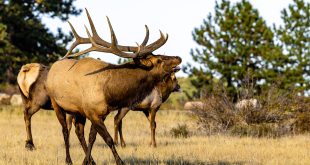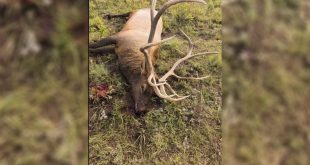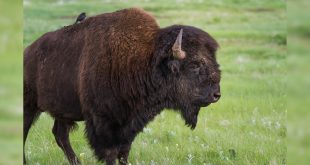Could the Wyoming winter have been avoided? Feeding deer?
By Ron Dean (Shared w/permission from Ron Dean PhD)
Dr. Ron Dean, who spent 33 years managing Wyoming’s state operated elk feedgrounds, writes, “It is hard for me to comprehend how an organization that has the motto of ‘Conserving Wildlife-Serving People’ can stand idly by and do nothing while one of the premier deer herds in the country is decimated by starvation.”
This blog originally appeared in Cowboy State Daily – July 16, 2023
I appreciate the opportunity to express my point of view. I earned a PhD degree studying this very thing, i.e., the nutritional aspects of feeding starving deer. I also spent 33 years managing Wyoming’s state operated elk feedgrounds.
Opinions regarding the supplemental feeding of big game within the Department varied greatly and I was often at odds with others. The debate of whether or not to feed starving deer is generally one-sided favoring those who oppose it. My intention here is to show another opinion regarding that issue. While I am critical of the Wyoming and Game Department’s effort dealing with last winter’s Wyoming Range mule deer herd, I still have great respect for the organization.
Why am I concerned?
Having read your recent article in Cowboy State Daily about the massive die-off of the Wyoming Range deer herd, I felt I needed to speak on the issue. It is hard for me to comprehend how an organization that has the motto of “Conserving Wildlife-Serving People” can stand idly by and do nothing while one of the premier deer herds in the country is decimated by starvation.
Reportedly, there were no surviving fawns and only 20 percent of the adults made it through the winter. Not only is last year’s fawn crop gone, but the surviving does most likely either aborted or resorbed the fetuses that would have been born this spring.
Two years of reproduction lost. The magnitude of this starvation was unnecessary. While Wyoming was doing nothing, Wildlife management agencies in neighboring states of Idaho and Utah opted to try to save deer by offering supplemental feed.
Why would Wyoming not make any attempt to save deer?
I can only speculate. The Wyoming Game and Fish continually tells the public the digestive system of deer is not capable of digesting artificial feedstuffs and to feed them does more harm than good. There are many valid reasons to not feed wildlife, but to blame digestive limitations lacks professionalism and preys on the gullibility of the public. For example, the following are taken from Wyoming Game and Fish information provided to the public. “Specialized feed is required to have any benefit to mule deer”. “Deer cannot benefit from many foods sources and can even die with a full stomach”. “Feeding deer will only lead to their suffering and potential death”. “The digestive system can’t adapt quickly enough, supplementally fed mule deer die with full stomachs. This is especially true when starving mule deer are fed hay”. “Even well designed and executed winter feeding programs fail to significantly increase the chance of mule deer survival”. “Feeding programs have repeatedly shown mule deer will often starve to death with full stomachs”. “Winter feeding programs for mule deer are only successful in making people who are compassionate about wildlife feel better”. It is my opinion that this mindset led to the demise of this once great deer herd.
What factors determine whether or not a deer will survive the winter?
From a nutritional standpoint, three things are involved. The level of body fat reserves entering the winter plays a big role in survival. Those with fewer reserves will be the first to die, which is typically fawns. Also, the amount of available forage is a major factor. Normally, most winter ranges have enough forage to sustain deer herds at desired levels.
However, snow depths and conditions vary and can preclude forge availability leading to starvation. Finally, the third factor relates to the management agency’s willingness to offer supplemental feed when the other two factors are limited. Delaying feeding or not feeding results in more deaths than any other cause when the other factors are limiting. Most deer winter die offs can be tied back to the management decisions that were made. Commonly, management agencies opt to ignore early warning signs and if feeding is initiated, it does not begin until after much of the herd has reached a point of no return. Large losses will then occur and agency’s escape is to blame feeding.
Do deer die on native ranges after being fed hay and other feedstuffs?
Yes. Native winter ranges cannot offer enough nutriment for deer to maintain body weight during the winter months. All deer will be on starvation diets until spring green-up. In general, how long a deer can survive depends on the level of fat reserves and the amount of nutriment it can get from native forage. But in any case, they cannot survive indefinitely and ultimately depend on spring green-up to save them.
People tend to think of a deer herd as one unit. For example, 500 deer in an area would be considered as one and viewed as a herd. In actuality, there would be 500 individuals, each with a different chance of surviving. Each animal is on its own path leading to starvation. Some will die early in the winter and some will be able to withstand long difficult winters. As fat reserves and forage availability decrease, the digestive system will eventually be affected to the point that it can no longer function properly and even though the animal is alive, it cannot recover. It has reached a point of no return. When a diet changes with ruminants, it takes a few days for the rumen microbes to adjust.
So, when supplemental feed is offered to a deer herd, those individuals that have reached to point of no return will die as will those who cannot wait for a few days for the rumen to adjust. These will have died anyway. So yes, some deer will die after being fed. The value of feeding is that keeps other individuals that would otherwise have descended into one of those conditions from reaching the point of no return. This allows deer time to gain sufficient nutriment to survive.
So yes, feeding does save lives. The sooner that feeding begins the more lives that will be saved. Most of the game department’s assessment of feeding deer is that it does no good or even is harmful for a variety of reasons. None will state that failed deer management was the cause. In most cases is feeding is delayed until many deer have already died and others are on the verge. It is not the feed, it is failed management and the timing of initiating feeding.
Can deer gain nutriment and survive on artificial feeds?
Absolutely. Anyone that has driven around in Wyoming has observed thousands of deer foraging on hay fields without ill effects. The Wyoming Game and Fish Department fed deer daily for many years near South Park. Advertisements on TV hunting shows promote various types of feeds designed for deer. While deer were starving to death on native ranges last winter, fawn survival was good on several local small herds that fed on hay offered to horses with some commercially prepared feedstuffs in some cases.
The logic that because dead deer have hay in their rumens and that the hay was the cause lacks rational thought. Are dead deer found near haystacks and other feeding areas with full rumens; yes. Was the feed the cause of the death; no. As starvation progresses, the ability of the digestive system to function properly decreases and a point will be reached that they are alive but beyond a point of no return. The fact that there is food in the rumen is irrelevant. Deer that die on native ranges eating only browse will also have material in their rumens. If malnourished deer could somehow be magically placed on native range with adequate browse, survival rate would be no greater than if the deer had been given artificial feedstuffs.
Why does the Game and Fish Department tell the public that deer cannot be fed when it obviously is not true?
There are many very legitimate reasons to not feed wildlife. But when the Game and Fish tells the public it is because artificial feeds either kills or allows deer to die, they are advancing a falsehood to a gullible public. Yes, deer will die after feeding begins and if feeding is delayed too long die-offs can be significant. But, it is not because of feed, it is because feeding was delayed until many deer had reached the point of no return. The Game and Fish sometimes prey on the gullibility of the public when it suits their needs.
What is the source of “killing deer by feeding” promotion?
That statement has been told and retold by many wildlife management agencies for many many years. I believe it stems from not wanting to get feeding started in the first place and may have more impact on the public as opposed to legitimate reasons like creating traffic hazards, luring deer into towns where shrubbery is damaged, etc. Within the Wyoming Game and Fish Department there is a segment of employees that are vehemently and philosophically opposed to feeding big game under any situation.
They have gathered support from some environmental groups and the Geological Survey in Bozeman, Montana. Department administrators have allowed these individuals free rein to promote their cause and has reached the point that much of the public and other department employees actually believe the non-native food sources does more harm than good. Much of the public believes this even though thousands of deer can be seen in alfalfa fields, captive deer are fed artificial feeds, local individuals let deer feed with their livestock, and artificial feeds can be purchased by the sack for the purpose of feeding deer. The list goes on and on.
How did adjacent game management agencies handle the winter of 2022-23?
The Idaho Fish and Game Department reported that deer were fed at 25 different sites. Estimates of the success of these were not reported. Information relayed to me from Daniel Ritchens of Henefer, Utah indicated that deer were fed at several locations in Utah. He personally fed about 2,500 deer, of which 47 had been collared by the Utah Division of Wildlife Resources. Of the collared deer, 40 were fed and survived the winter.
Ten did not attend the feeding sites and died. One deer attended a feeding for only one day and it died. More in-depth information about Utah’s Department of Natural Resources effort to feed deer can be seen on YouTube (link not working) feeding data appear at about 2 hours 26 minutes into the presentation). Data there show that feeding which beginning in late January saved 70 percent of the fawns. Those that were not fed died. Feeding survival of adult deer was 90 percent for those fed and 50% for those not fed.
What is your recommendation for the future?
The possibility of needing to feed on rare occasions should not be ruled out when warning signs appear early in the winter as was the case here. Emergency feeding plans should be in place and used if the need arises. For example, the Utah’s Department of Natural Resources has “trigger points” in place. Feeding begins if those points are met. Timely feeding can prevent catastrophic losses. However, game departments have many excuses to not feed and commonly it is public pressure that results in initiating the feeding which happens late in the starvation process and losses can be great.
Should chronic wasting disease been a factor in deciding whether or not to feed?
Chronic wasting disease can be considered a “wild card” in this situation. The disease is 100 percent fatal with deer and kills them at a relatively young age. It has had detrimental effects on deer herds. Presumably it would be spread more rapidly if deer are in close contact with each other. This could be the situation if the deer were fed in a manner that put them in close contact with each other. However, given the terrain of much of the deer winter range, deer could be fed in a manner where they are scattered, perhaps even greater than when feeding normally on winter ranges.
The bottom line is the disease is working its way across Wyoming and will be here, if not already in the Wyoming Range deer herd. Given, I am not a disease expert and can only use a layman’s approach to assessing the situation.
Using the most recent information as presented in Cowboy State Daily, less than 3,800 survived last winter from the 28,000 head that entered the winter. CWD will likely be present and will affect the herd’s ability to recover its former numbers. It seems to me that had feeding begun early enough to save most lives, the herd would have had a better chance to recover. Given the buck/doe ratio as presented in the 2021 Annual Report and the reported adult survival rate for last winter, less than 2,700 does are left to rebuild the herd. This deer herd may never recover given the presence of predators, the potential effects of CWD, and the possibility of more harsh winters.
Is cost a factor in feeding?
The public information from the Game and Fish Department states “feeding large numbers of deer over entire winter ranges is not economical for Game and Fish and does not outweigh the negative impacts”. I have been out of touch with the financial information of the Department in recent years but there was a time that revenues from license sales from the deer and antelope programs were the only ones operating in the black. All others operated in the red. It will be interesting to assess that statement after comparing the lost revenues from license sales resulting from decimation of the Wyoming Range deer herd for the years to come.
Summary
Regardless of whether or not the feeding efforts in Idaho and Utah are considered successful not, they can at least say “we tried”. Wyoming cannot say that even though a magnificent deer herd was basically lost for many many years to come, if ever. However, they can still promote their motto “Conserving wildlife, serving people”. The bottom line is deer can be successfully fed and it is time to move on to the next argument. I fully expect a rebuttal from the Game and Fish stating why their course of action was the proper thing to do and I can predict their reasoning. However, it will be hard to convince me that the apathy shown last winter was in the best interest of the deer and the public.
As a Game management organization, the Wyoming Game and Fish is second to none. However, I do believe they let one slip through the cracks last winter.
Ron Dean lives in Etna and is retired from the Wyoming Game and Fish Department, he ran the agency’s elk feeding program for 33 years.
Source Link
 Eastmans' Official Blog | Mule Deer, Antelope, Elk Hunting and Bowhunting Magazine | Eastmans' Hunting Journals
Eastmans' Official Blog | Mule Deer, Antelope, Elk Hunting and Bowhunting Magazine | Eastmans' Hunting Journals




